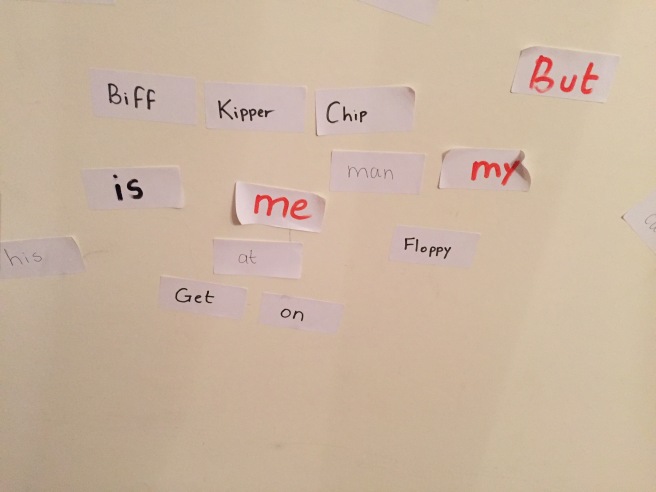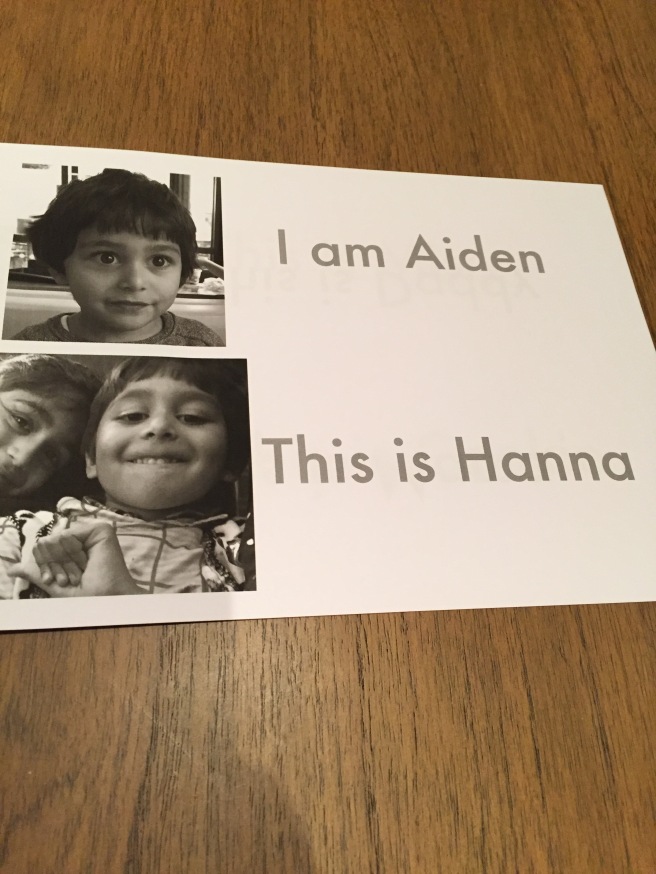I had an interesting conversation with a close friend yesterday. She is someone who has known Aiden since he was born and has had the opportunity to see him on, nearly, a daily basis. She expressed a lot of surprise that Aiden is autistic, that if I had not explicitly stated it she would never had thought he is on the spectrum. We get this a lot, A LOT! Friends, family, well meaning strangers look at us like we’re slightly nuts when we mention Aiden and autism in the same sentence. I have heard statements like “Are you sure? But he looks so normal”, “No way! He’s just immature”, “He’s growing at his own pace, don’t despair, you’ll laugh at all this in a few years.”
I promised my friend yesterday that I will blog about Aiden’s autism next. So the aim of this post is to attempt to tackle the sheer diversity of development issues that make up the autism spectrum disorder. I don’t blame people for saying what they say. When you mention autism it will conjure up images of the extreme form of the disorder. You can spend a whole day with Aiden, and if your life has not been touched by autism, you will never see it. For instance:
-Aiden has a full range of facial expressions. In fact, since he has delayed speech he uses his expression somewhat exaggeratedly.
-Aiden is incredibly sensitive to people’s moods. He has a very high level of emotional intelligence, something that classically autistic children lack. If he’s pushing the boundaries he will look at people’s expression to check just how far he can go. His heart breaks when he’s scolded, especially if it’s Daddy who scolds him. Daddy needs to raise one finger for Aiden to get in line! No words needed.
-Aiden craves physical affection. Since he was a baby he has loved to cuddle. With his people he will want a physical expression of their love, no, need this expression. From the pet cat to parents to class teacher, Aiden can happily cuddle with you very quietly, very peacefully.
-Aiden doesn’t need prompts to express socially appropriate statements. If he’s stepped out of line, he knows it and will apologise. He verbalises all his needs. He says thank you as often as can reasonably be expected from a 4 year old boy. Though much of his emerging speech is echolalia, he is employing this to express his emotions. (The other day when he was upset with me, he looks me in the eye and says: I am not talking to you! This is what Peppa Pig says to Suzy Sheep when they had a fight).
-Aiden is super easy to deal with when we travel, when we have changes in routine, when we visit new, unknown environments. He takes change in his stride and is not a slave to routine.
-Aiden doesn’t have any physical ‘stims’. Stimming is a repetitive behaviour that many autistic individuals need to soothe themselves. Some flap their arms, some rock themselves, some flick their fingers. It’s an attempt to self-calm. (I obsessively pick my cuticles when I’m upset. It helps me calm down. Somehow that is socially acceptable, disgusting as it may be, but arm flapping isn’t!).
-Aiden does not tantrum. Mind you, we would have tantrums, but the sort that any child would have. Nothing so extreme that it would draw people’s attention. We have not had to readjust our family’s life around him to prevent the possibility of a meltdown.
So after reading all this you’re wondering how Aiden falls on the autism spectrum. This is why:
-In four years, Aiden has never brought us a piece of artwork for us to smile over together, he’s never pointed at an airplane leaving a cloud trail and shared his wonder, he’s never shown us something that he’s found fascinating, interesting, some creation of his that he particularly proud of. This is called shared or joint attention. Its complete lack in Aiden is one of the biggest red flags of autism.
-Aiden’s speech is now emerging at a rapid click. But much of this is echolalia. Echolalia is when a child perfectly mimics, down to tone and inflection, something that he has heard. In Aiden’s case it’s snatches from his favourite cartoons. Sometimes listening to him speak is like watching an episode of Charlie and Lola. It leaves us in fits. Yesterday in the car he kept repeating the following dialogue for a good ten minutes:
Stop it!
I can’t stop it!
This was done in two different voices. We were all laughing, including Aiden, at how strangely appropriate this was.
-Aiden has so far developed no social skills with his peers. He has now got to the point where can play alongside other children. He is no longer fiercely protective of his space, he’s using other skills to let other children know not to take his toys, he’s learning to let go of a toy, share it, he is no longer lashing out at others walking into his space. While we have made this much progress, he is still most comfortable when he is on his own. Other children in his area are tolerated, at best. There is no evidence yet of him sharing his play with others.
-While Aiden indulges in a lot of pretend play, his play is very repetitive. His favourite toys are dolls and doll houses. Doors are current obsession. But he needs his dolls to be lined up just so, in perfect symmetry. They need to go into the house in a particular order. They need to sit in their camper van and go for a picnic in certain way. This obsession to order, this attention to incredibly minute detail, is very important for Aiden and any divergence from this causes him stress.
Aiden was first red flagged for autism at age 2 and half. He was immediately put into therapy to address his issues. This is absolute best possible scenario for a child with autistic tendencies: the earlier you intervene the better the outcome once a child gets to grade school. Aiden also lies on the extreme fringe of the spectrum. His technical diagnosis is high functioning, mild, pervasive development disorder-not otherwise specified (PDD-NOS). In terms of achieving a fully functional, independent existence this is the best form of autism you can have (yes, that was written with tongue planted in cheek).
Understanding PDD-NOS is very hard. You’re basically ticking just enough boxes to hang off the autism spectrum by the skin of your nails. It’s also very unhelpful that the high functioning fringe of ASD is in a state of constant flux. Initially the high functioning end of the spectrum was divided into PDD-NOS and Asperger’s. Recently Asperger’s has been ‘discontinued’ as a distinct diagnosis. Adding to the confusion is that the Diagnostic and Statistical Manual of Mental Disorders-4th ed (DSM-IV) devotes one paragraph to PDD-NOS and basically tell you what it’s not, not what it is:
“This category should be used when there is severe and pervasive impairment in the development of reciprocal social interaction associated with impairment in either verbal or nonverbal communication skills or with the presence of stereotyped behavior, interests, and activities, but the criteria are not met for a specific Pervasive Developmental Disorder, Schizophrenia, Schizotypal Personality Disorder, or Avoidant Personality Disorder. For example, this category includes “atypical autism” – presentations that do not meet the criteria for Autistic Disorder because of late age at onset, atypical symptomatology, or subthreshold symptomatology, or all of these.”
Of course one can take the course that Hassan takes. When asked what PDD-NOS is he says it basically means “I have no f**king clue”. When asked what Aiden has, he says he’s got something called “Being Aiden”. PDD-NOS or Being Aiden, whatever it is, Aiden has got a family that will move mountains for him. That he will be given the best support he needs, no matter what the financial or emotional cost, is a foregone conclusion. We have no doubt that Aiden will be a fully functioning, independent, productive member of society. In fact he may go on to find the cure for the common cold or to colonise Mars or do something that changes the course of humanity. Of course we will always be protective of him, of course we will always worry about him. But what parent doesn’t? Regardless of whether your child is “typically developing” or has “special needs”. Everyday of his life Aiden has brought us nothing but joy. If we can wave a magic wand and take away his quirk, we honestly, hand-on-our-hearts, would not. Because we love him just the way he is, we celebrate his oddities and his little triumphs because they are him, we would never ever have it any other way.
If you want to know more about PDD-NOS, this is a great link: https://www.autismspeaks.org/what-autism/pdd-nos

 To augment this learning I have started using an assistive app. (I am a HUGE fan of assistive technology. While acknowledging the very divisive nature of iPads, I have found them to be invaluable in augmenting my children’s learning). Nessy are makers of literacy apps that I have used in past with children with a range of learning and development difficulties. Their app Hairy Words takes children through the entire one hundred high frequency sight words, teaching children to read, spell, and type the words. Aiden finished the first twenty words in less than a week. He is completely taken with this app. I have it on my iPhone and allow him to ‘play’ with it at random places. It kept him very calm, happy, and settled during a four hour long new years’ party with school friends.
To augment this learning I have started using an assistive app. (I am a HUGE fan of assistive technology. While acknowledging the very divisive nature of iPads, I have found them to be invaluable in augmenting my children’s learning). Nessy are makers of literacy apps that I have used in past with children with a range of learning and development difficulties. Their app Hairy Words takes children through the entire one hundred high frequency sight words, teaching children to read, spell, and type the words. Aiden finished the first twenty words in less than a week. He is completely taken with this app. I have it on my iPhone and allow him to ‘play’ with it at random places. It kept him very calm, happy, and settled during a four hour long new years’ party with school friends. And this week my goal is to get Aiden writing simple sentences. Again, the biggest obstacle is his inability to formulate sentences that are his own. His independent, non-echolalia speech is still limited to 2 or 3 word phrases. So I have started with a very simple context: his family. Providing him with visual prompts, simple and repetitive sentences, and a writing frame the idea is to get him to become secure with extremely basic social communication. He will read the sentence, contextualise the language with the visual prompt, and trace over the words while saying them out loud. Well, thats the idea anyway. We will see if it works. Personally, I will be well chuffed if I can get him to start saying “I am Aiden” when he meets people.
And this week my goal is to get Aiden writing simple sentences. Again, the biggest obstacle is his inability to formulate sentences that are his own. His independent, non-echolalia speech is still limited to 2 or 3 word phrases. So I have started with a very simple context: his family. Providing him with visual prompts, simple and repetitive sentences, and a writing frame the idea is to get him to become secure with extremely basic social communication. He will read the sentence, contextualise the language with the visual prompt, and trace over the words while saying them out loud. Well, thats the idea anyway. We will see if it works. Personally, I will be well chuffed if I can get him to start saying “I am Aiden” when he meets people.

 (My boxes for Literacy, Numeracy, Logic/Problem Solving/Motor Skills, Craft, and Stationery.)
(My boxes for Literacy, Numeracy, Logic/Problem Solving/Motor Skills, Craft, and Stationery.)





